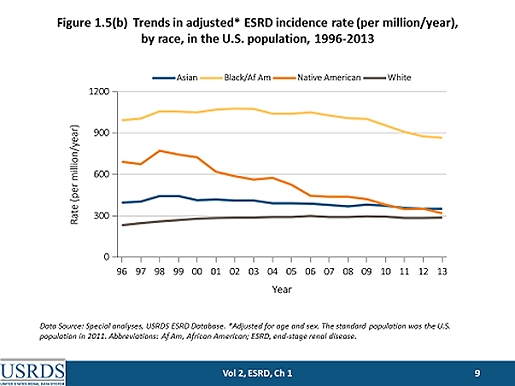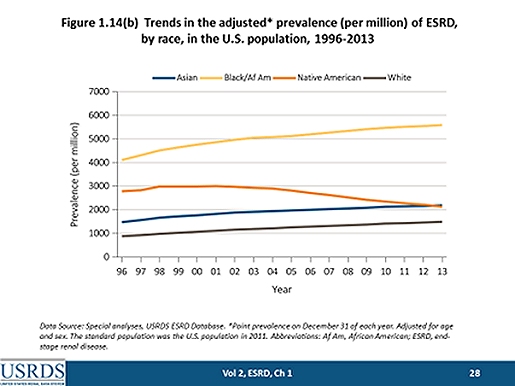Diabetes affects the American Indian and Alaska Native population at almost twice the rate of the general U.S. population. To help end this health epidemic, Congress has committed $150 million per year through fiscal year 2017 for the continued prevention and treatment of this disease. The IHS Special Diabetes Program for Indians provides funding to more than 300 IHS, Tribal and Urban Indian health programs. Read about the successful Diabetes Program at IHS.
Though more work is needed, we celebrate some good news for American Indian and Alaska Native people this month, which is American Diabetes Month. The United States Renal Data System, the national registry that collects information on end-stage renal disease in the United States, recently released its 2015 Annual Data Report . This report stated that two important metrics for American Indian and Alaska Native health continued to change in the right direction: both new cases of end-stage renal disease (incidence) and the total cases of end-stage renal disease (prevalence) have declined for Native Americans. Even more remarkable, these improvements are outpacing those of all other racial groups in the United States.
End-stage renal disease is when the kidneys stop working well and the patient requires dialysis or a transplant. This kind of kidney failure is permanent and cannot be fixed. Most cases of end-stage renal disease are caused by diabetes or high blood pressure.
These data are truly amazing--it shows that we're doing something unique in our communities that is working even better than in the general population. As the Indian Health Service strives to work closely with our Native patients and communities, it is encouraging to see these dramatic improvements in healthcare data for those affected by diabetes and other causes of end-stage renal disease.
Dr. Ann Bullock is board-certified Family Physician and the Director of the IHS Division of Diabetes Treatment and Prevention. DDTP provides information and resources to strengthen clinical, public health, and community approaches for diabetes treatment and prevention in Native American communities throughout the United States.

This chart from the United States Renal Data System demonstrates that end-stage renal disease incidence rates for Blacks, Native Americans and Asians have declined over the nearly 20-year period shown. The decline has been greatest (over two-fold) among Native Americans.

According to the United States Renal Data System "…the remarkable decline in incidence rates among Native Americans has resulted in a 29 percent decline in the prevalence of end-stage renal disease in this population since 2000. This represents the only instance, since the beginning of end-stage renal disease care in 1973, of a decline in adjusted prevalence for a major racial group."



